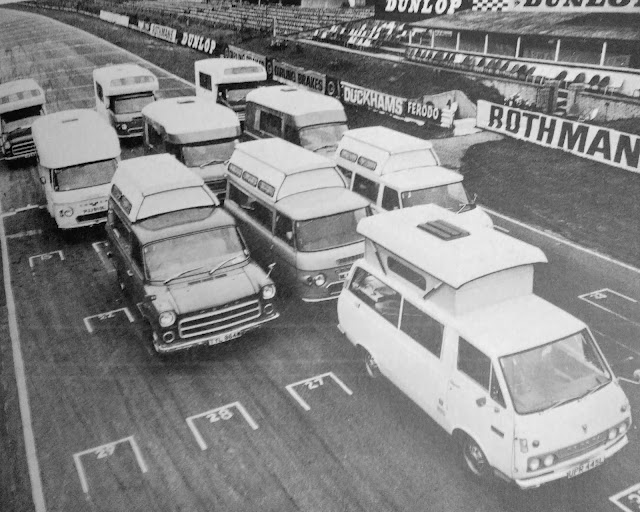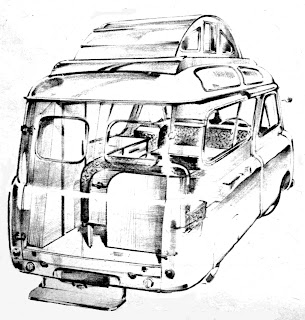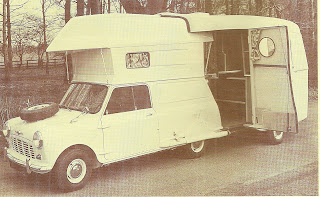Retro/Vintage Vanlife; Campervan Profiles
Classic & retro vanlife, vehicle profiles...
In this blog, I am going to take a look back at some campervan profile sheets I produced some years ago for the now defunct 'Motor Caravan Magazine' in the UK. These were a 'cut-out-and-keep' profile included within the magazine over a period of weeks, featuring some of the popular classic British campers and motorhomes. These were written under the pseudonym of 'Perry Thacker', but of course I am better known as Martin Watts, campervan historian/author and general classic motorhome nut!
 |
| Let's start with one of the best selling motorhomes within the UK throughout the 1960s; the Ci/Autohomes 'Highwayman'. |
The Highwayman was first released by Bluebird Caravans in 1958, based on the Austin-Morris 152/J2 light commercial chassis. With the release by Rootes in 1960 of the Commer range, customers were given the option of both the Austin-Morris and Commer as a platform for the Highwayman motorhome. By 1964 Rootes own campervan model, the 'Maidstone', was discontinued in order for Rootes/Chrysler to concentrate all their sales efforts into the Highwayman, now only available on the Commer chassis. It quickly established itself as the best selling motorhome in the UK.
The prototype for the unique 'Sun-Tor' campervan first appeared in 1968, based on the BMC 1/2ton van, badged as both Austin and Morris, which was basically the Austin A55 and the Morris A60. Born out of 'Webster Conversions' of Sussex, England, Ron Webster had been converting panel vans into campervans during the 1960s, mostly on the Bedford CA base. Moving the business to Torrington in Devon proved to be a wise move, as sales of the small Sun-Tor campervan took off in the late 60s. The company name became 'Torcars', and the little Sun-Tor gained a steady stream of admirers and buyers.
This was a British attempt at a campervan conversion similar to the 'turtle-top' models made popular in the USA. Created by the long established Canterbury company in the UK, the Sunhome was a well designed model, giving a feeling of spaciousness within a confined area, due mostly to the large glass-fibre roof. Sales were mediocre at best, with the model becoming more of a novelty campervan with the British public rather than a serious contender to rival the established models of that time. The Holdsworth conversion company also came up with a similar design which they called the 'Holdsworth Hi-Flyer'; it met with the same disdain by the public, and failed to create waves within the industry.
One of my personal favourites from the late 1970's, this is the Auto-Sleeper CB22 motorhome, based on the Bedford CF chassis. I am biased because I owned one of these models for several years, and enjoyed mostly because of the superb interior design; compact and yet spacious.
An extremely attractive motorhome, the Cotswold C-Series was available during the 1960s based on the Austin 152/J2, and later the 250JU chassis. Cotswold of Gloucester, England produced some very fine motorhomes throughout the 1960s and into the early 1970s on a variety of chassis, including the Ford Transit MKI, Mercedes, Austin FG, and Ford A-Series.
I'm not sure if it was down to poor marketing by Cotswold, or simply that the British public did not like the Caravelle model overall, but it certainly did not set the sales charts alight in the UK during the early 1970s.
The Dormobile 'Freeway'
They were one of the most prolific producers of motorhomes/campervans in the UK throughout the 1950s, 60 and 70s, Martin Walter Ltd (Dormobile) of Folkestone, Kent. Here I feature their top-selling model of the 70s, the 'Freeway', based on the Bedford CF, though it was also available on the MKI Ford Transit.
In addition to sales in the UK, the Highwayman was also sold in North America as the 'Sunbeam Funwagon' through Rootes vehicle dealerships. In the UK, the Highwayman topped the sales charts for motorhomes during the 1960s, and only began to fall down the pecking order with the introduction of models such as the Ford Transit Landliner, and the Autohome, (on the Commer, Bedford CF and Transit) which is pictured at the top of the page as a cut-away illustration.
The Commer Highwayman remained in production until 1975, and at that point the model name was transferred to the new Leyland Sherpa chassis. With the introduction of the Talbot Express in the 1980s, the Highwayman model name was once again transferred to the Talbot Express Highwayman.
The Torcars, 'SunTor'
Promoted as the campervan which you could fit into the average family garage, it was diminutive in size and yet well designed on the inside, with cooking facilities, a double bed, ample storage cupboards, as well as a full height rising roof.
It continued in production until the early 1970s, when the Morris Marina was introduced, and the Morris Marina Sun-Tor became the best selling 'micro campervan' of the 70s.
The Canterbury 'Sunhome'
Auto-Sleeper CB22-Bedford CF
The CB22 was only available on the Bedford chassis, which was a great shame, as I believe it would have been one of the best selling motorhomes in the UK had it been offered on the MKII Ford Transit platform. It was sold as the 'complete motorhome', requiring no optional extras. The interior wooden finish was of a very high standard, and the mid-section of the interior was angled in such a way that it played tricks with the mind, leading you to believe that the van was much bigger than it actually was. Every mod-con was fitted, from gas heater to hot water system, shower/washroom, full height wardrobe, cocktail cabinet, full oven and grill, plus two large double beds. Typical of so many 1970s motorhomes which used the construction method of aluminium panels over a wooden frame, they did suffer from water ingress after a few years of use, mostly around the large side windows. Remaining/surviving examples are now few and far between, but what a cracking model it was.
The Cotswold 'C-Series' motorhome
 |
| Cotswold are also credited with producing possibly the first high-top campervan in the UK in 1960, as seen above. |
The interiors of the Cotswold conversions always had a light wood grain-effect and a light airy feel inside. They were well designed, and at the higher end of the price range for UK motorhomes. The C-Series featured here was one of, if not the most popular Cotswold model in their range. The only drawback with this model was the limited dimensions of the double bed, in length not width. Anyone 6ft tall and over would find the bed rather short, though this is the only gripe I ever heard about this particular model.
 |
| The Cotswold Caravelle was only available on the MKI Ford Transit. A larger motorhome, the 'Concorde' was also available, again on the MKI Transit chassis. |
I'm not sure if it was down to poor marketing by Cotswold, or simply that the British public did not like the Caravelle model overall, but it certainly did not set the sales charts alight in the UK during the early 1970s.
In fairness, it was up against the Ci/Autohomes models such as the 'Autohome/Motorhome' and 'Landliner', also on the Ford Transit, and priced more competitively, though you tend to get what you pay for, and the Cotswold Caravelle was a motorhome of far superior quality. As a result, not that many were produced and I doubt that more than a handful have survived.
 |
| The double-page spread featured above, is copy I compiled some years ago relating to Cotswold motorhomes. |
The Dormobile 'Freeway'
They were one of the most prolific producers of motorhomes/campervans in the UK throughout the 1950s, 60 and 70s, Martin Walter Ltd (Dormobile) of Folkestone, Kent. Here I feature their top-selling model of the 70s, the 'Freeway', based on the Bedford CF, though it was also available on the MKI Ford Transit.
Widely regarded as one of the most luxurious motorhomes of the 1960s and early 70s, the Roadranger was released in 1964, based at first on the Austin-Morris 152/J2, and later on the Ford Transit, Commer, Bedford CF and Leyland 20 (Standard Atlas).
The Roadranger was hand-crafted by J H Jennings Ltd of Sandbach, a British coachbuilder of great renown. The interiors were built from solid wood, in light, medium and dark timber, depending on customer requirements. The exterior of the Roadranger was very distinctive, with a rounded roof of glass-fibre, the trademark Jennings side flash, and louvre side windows.
The Jennings Roadranger ran from 1964 up to 1973, then J H Jennings were acquired by truck maker ERF. They then released a new motorhome as the 'ERF Roadranger', with revised interior layout, on the MKI Transit and Bedford CF, with a few built on the Ford A-Series chassis.
 |
| The Jennings Roadranger on the Rootes/Chrysler Commer, as seen in a publicity shot. |
 |
| A specification sheet for the Roadranger based on the MKI Ford Transit. |
The later ERF Roadranger, on the Ford Transit. This is my ex-Roadranger dating from 1974. Note that the ERF version had a side/rear door, unlike the earlier model which had a single rear door.
The 'Paralanian' motorhome
Built in Parry Lane, Bradford, by Central Garages, the Paralanian was marketed as the 'Rolls-Royce' of British motorhomes, and with good reason. First released in 1957, it was by far the most luxurious production motorhome on the market. The all wooden interior simply shouted quality,as did the beautifully upholstered seating and Axminster carpet!
Initially the Paralanian was only available on the Austin 152/Morris J2, but later the Rootes Commer became a chassis option.
 |
| The first Paralanian examples were very similar in appearance to the Bluebird Highwayman, with the rear box-like design. |
 | |
|
Ford Transit 'Sprite Motorhome'.
Released in 1966, The Sprite was built by Ci (Motorised) Ltd in Poole. It was only built on the MKI Ford Transit, and ended production with a MKII version in 1970, after less than 100 examples had been built.
The exterior design belies the company tradition of building Sprite caravans. A traditional coachbuilt example of the 60s using an aluminium skin over a wooden frame. The MKI model of the Sprite Motorhome was a slightly better model than the later MKII from 1969/70. With a mixture of arrangements, the Sprite could sleep two adults and four children (with the addition of various bunk beds). It featured a rear corner washroom/shower/toilet, a dinette for four people, a full length kitchen along the nearside and various storage cupboards, including a wardrobe.
Ford Transit Wayfarer
Another campervan model from 'Caravans International (Motorised) Ltd (Ci/M) of Poole, England. Again, the Wayfarer was a poptop model which was only available on the Ford Transit chassis. Ci/M also released similar versions on the Commer , which they named the 'Wanderer', and on the Bedford CF, which they called the 'Brigand'.
All three models were extremely popular during the 1970s, and sold in relatively large numbers.
The photo above was a pres day held at Brands Hatch racing circuit in the 1970s, and this particular picture shows the various Ci/M models on the grid. The Transit Wayfarer, Commer wanderer and Bedford Brigand can be seen on the second row, behind the Toyota Ci Camper.




















Comments
Post a Comment